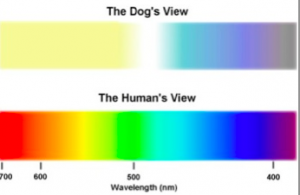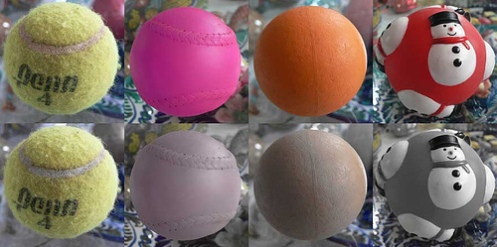Differences Between a Dog and a Human’s Visual Perception
I’ve always been unable to completely understand the difference in my dog’s vision as compared to my own. It’s as if I cannot step out of my own realm of vision to expose myself to how my dog views the same world we both live in. It’s even in the most simple of things, for instance, how she views a movie as compared to how I view it, the lack of color she is exposed to as compared to the vibrancies of colors I see every day, and her ability to see in the dark as if it were the middle of the day whereas my vision, even when it has grown used to the dark, is still fuzzy and not very sharp. My dog’s sense of vision is not the one she relies on like humans do, but rather, hearing and smell are what guide her through every day life.
When comparing a human’s vision, like my own, to a dog’s vision, it is as if what one lacks, the other supports. While dogs are able to detect sudden movement off in a distance, humans can detect objects that are not moving at a far distance better than a dog can. Their abilities to see sudden movement compared to seeing stationery objects is mostly due to their prey factor outweighing the other. This is why an animal, such as a rabbit, will stay still the moment it detects that a dog is around because the dog will not likely see the rabbit unless it makes a sudden move to get away. Humans also have the ability to see things clearer when they are close up as well, whereas dogs cannot. This would explain why my dog will sit at my sliding door window and bark continuously at a white, plastic bag until I let her out to go see what it really is. Her perception is blurred because of how far back in the woods the bag is, but the fact that it is fluttering around from the wind makes her think it is an animal of some sort.
Motion is a big factor in a dog’s vision, and they need more of it to see things clearer and understand what exactly they are seeing. Take a movie, for instance; a dog needs more frames in a second in order to understand the scene and what is going on. Their vision is reliant on fast moving objects to detect what they are seeing, and even then they may have no idea. This is where the difference of colors comes in when comparing what a human sees and what a dog sees. A dog’s ability to see color is a lacking factor, and I would be lying if I didn’t say that I would hate to see a dog’s colors over my own. Dogs cannot make out the difference between reds, oranges, yellows, and greens. For instance, in the picture below, a human’s view of a human is distinctively different than a dog’s view of a human.
A dog’s inability to see details like humans do goes hand-in-hand with their slight color-blindness. Although a dog’s vision is not completely black and white, like humans often believe, it is not a far way off from that. Dogs are not ability to tell the difference between greens and grays, along with most other colors on the color scale. This may have some relation to their ability to see in the dark due to the fact that their eyes are not used to color in the first place. Therefore, their eyes do not need to adjust to the dark the way a human’s eyes would need to, but rather, they see the world almost entirely the way they see it during the day. A dog’s view of color affects the toys they play with as well, which was something I was unaware of until getting deeper into the subject. In the picture below, a tennis ball is viewed the same, whether it be through a human’s eyes or a dog’s eyes. Whereas, every other colored ball would not be perceived the same way by a dog as it would a human; instead, it would blend in with the rest of the world which may be why many dogs do not even make the effort to go after it, depending on the background.
The difference in a human’s color vision and a dog’s color vision is the fact that dog’s have fewer cones which makes their vision lack the color that humans see. Humans have different types of cones which gives them a widespread of color, whereas a dog’s wavelength of light is limited and dull because they do not have a variety of cones. The differences in wavelength for humans and dogs can be viewed below. While a dog does not only see black, white, and grey, their color is very limited and borderlines what humans believe is color-blindness in dogs.

Needless to say, the seasons Spring, Summer and Fall do not affect a dog, which would be very disheartening for a person like myself. My dog’s view of life is almost completely different from my own, and I understand why she does the things she does and her reasoning for it. I live inside my own life so much sometimes that I don’t always step outside of the box and look at how others, even dogs, portray this world that we live in together. I feel that my dog and I benefit each other, and although she does not see too much color, her abilities to notice sudden movements and see in the dark help to protect me and that puts me in a better state of mind. So I will go on living in my dominant visual world while she focuses hers on hearing and smelling, and I will better understand her and how to help her perceive the world, plastic bags and all, the way she sees it and the way it really is.
References:
Coren, Stanley. “Can Dogs See Colors?” Psychology Today (2008): n. pag. Psychology Today. Canine Corner, 20 Oct. 2008. Web. 16 Feb. 2013.
Dog Eye Problems.” Eyes / Sport Dog Training. Retriever Pro, 2006. Web. 16 Feb. 2013.
Mathiesen, Shawn. “The World Through a Dog’s Eyes, Ears, and Nose.” Chestertown Spy. N.p.,7 August 2012. Web. 16 February 2013.


In some ways, I feel like a dog. Not because of their actions, no. But for the fact that I tend to see a lot like they do. Not the same colors though, considering I’m blue/yellow deficient. But this is a subject I’ve often wondered about as well. Not only with dogs, but with other pets, like my bunny. Here I found that, like a dog, rabbits have dichromatic vision as well. However, bunnies can’t see yellows and blues, just like I can’t. Bunnies can see reds, greens, and oranges. That tends to be why most bunny toys are red and orange. Also, it explains the color of carrots very well too.
What was said about bunnies seeing reds, greens and oranges and the color of carrots got me thinking about the concept of coevolution. Rabbits eat carrots so it makes sense that they would need to see orange. They also eat greens like grass, lettuce, and corn stalks supporting a need to see green. I cannot think of anything a rabbit would eat that is red. However, rabbits tend to be prey so it makes more sense that these colors correspond with predators. Tabby cats are orange. But I’m thinking more along the lines of snakes that run the color spectrum from green to orange to red. Granted snakes in turn also adapted. An orange or red snake would standout in green grass however a green snake would blend in until it moved. Then of course there are the host of snakes that are not these colors. Very quickly the web of interconnection and interdependence between plants and animals and other animals becomes evident. As one varies or adapts the rest must do likewise or perish.
After reading your blog I ventured on a quest to find more information on canine color vision. What I found was a little surprising.
A television channel designed especially for canines that takes their color vision into account. The before and after pictures in the video suggest the difference between what a dog sees when looking at a program on a regular television channel and one on DOGTV. Granted the content of this channel is dog oriented (what will they think of next?), the connection with humans with similar color deficiencies crossed my mind. Depending on the type of color deficiency watching television must have its challenges. HD could mean nothing more than high definition grayness or a more crisp looking yellow rose that is red to someone with trichromatic vision. I guess that is why those buttons to adjust hue, brightness and contrast are on the televisions. Adjusting these settings is akin to color-matching experiments.
I’ve always wondered what the world looked like from my dogs’ eyes. I have four dogs currently, but I’ve always had one as a pet and I remember being little and trying to get on their level and looking at the world through their eyes. Obviously as a kid you’re told that dogs see simply black & white, or grayscale, whatever you want to call it. After reading your blog and watching a couple shows on Animal Planet growing up I realized that their level of vision is over and under our capacities if one could say that. It is definitely true what you said about both of our visual capacities making up for each other in a way. One of my dogs in particular is very catlike, in that she enjoys chasing little dots of light all over the walls and things much like cat laser pointers and knowing what I kow now about her vision in the dark I can understand how she does this so well. She’s a miniature pinscher and they were originally bred to be rat hunters as most terriers so I kind of get how she can chase the little lights around in the dark. When I wave the little light around on the floor and things if I do it too quickly, I somtimes lose track of the light and my eyes have to sort of catch up! Great blog topic, I loved reading about this and I guess I’m going to play with my dog a little bit more now!
I am so happy you wrote about this for your blog. I sit and look at my dog all the time and wonder how he is seeing the world and how he portrays things. He often will sit and watch the television, and I wonder if he sees what I am seeing. And then when a dog is on the television he goes crazy so then I think he must see what I see. I also have always thought that dogs see in complete black and white, or even maybe in a grayscale. I was very intrigued by the fact that they can some color. My dog is a black lab, and while seeing may not be his thing he is quite good at opening doors. There is not a single door in my house that is unable to open, and yes this includes the refrigerator. It is very disappointing when you have to keep a child lock on the fridge to keep your dog from eating you out of house and home, because he will get in and help himself to anything he chooses. Anyway back to my point. He often will open the front door of the house and run out. I think he thinks it is a game of some sort. But with him being a black dog when he would run off at night it would be almost impossible to find him, but with his good vision at night, well better than ours, he would always see me coming after him and run even further away. This is very frustrating. So I was very happy to read your blog and learn something new from it, and something I have always wondered about. Cool blog!
Thanks to your post I understand now why my dog used to play with me or at least that was what I used to think before I read your post. I approached very slowly to her and suddenly jump on her, I thought she was playing with me because she just waited for me to approach and then in the last minute she just ran as she was seeing some kind of ghost. Before your post, I believed she was pretending not to see me but I know now that she did not really see me.
It is important not to think that the information we get from the environment, it is the same information others could get from the same scenario. What we see as a reality, it is only the interpretation of our brain.
Now that my border collie is older, his eyesight and hearing as not as good. His sense of smell is great! He still can detect motion – border collies are especially bred for that! When I toss objects for him, he can easily get then while they are still in motion, but once they land he can no longer find them by sight.
In training a working border collie, one uses calls to indicate the desired move, but these calls are always accompanied by large sweeping movements of the arm or stick. In the field, distance or wind might preclude a dog’s missing the call, while movement catches their attention no matter how slight!
This is a great topic because so many people can relate because they have dogs or have dealt with dogs directly at some point. I always was aware that dogs had difference sense of smelling and hearing because they are able to hear at very high pitches, which we cannot and have a great sense of smell. I didn’t realize that their sight was so different from ours but I guess it makes sense that they have such pronounced sense of smell and sound because they lack it in sight. It is understandable that they see things and are not able to see all the colors as we do but I didn’t realize that their depth is very different from ours as well. I never realized that dogs cannot see far in the distance and may not detect an object until it is very close to them. I do not have dogs myself but I am going to try to pay more attention to my brothers dogs to see how they react to certain things.